By Larry Boulden Staff Editor
Several major research projects are underway to enhance energy efficiency of hydraulic systems, and to use those efficient hydraulics to reduce the cost of operating variable-power systems. Some of these programs are leveraging the known strengths of hydraulics into new areas. Others aim to encourage engineers designing hydraulic systems to opt for power-saving features and efficient circuits. Here are a few key developments that make hydraulic systems more “green,” more efficient, and that tap efficiency to create energy-saving alternatives to conventional equipment.

Fig. 1 — Environmental Protection Agency predicts a 30-70% increase in fuel mileage for a heavy vehicle with lots of stops and starts, like the one shown in Fig. 2.
Seminars teach energy saving
One measure of the increased interest in saving energy is the enthusiasm for learning how to design efficient fluid power systems. This desire to learn has led to recent seminars offered under the auspices of the National Fluid Power Association (NFPA), and taught, most recently, by the Milwaukee School of Engineering (MSOE).
One recent seminar, taught by Dr. Medhat Khalil of MSOE’s Applied Technology Center, looked at the ways to design more efficient, fuel-saving hydraulic systems. Dr. Khalil asks four key questions:
1. What are the sources of energy waste in hydraulic systems?
2. How do we evaluate energy wasted in them?
3. What are the circuit solutions for best energy management?
4. What are the operational recommendations to save energy in hydraulic systems?
Inefficiencies arise in several major areas, including the components used, the circuit layout, system design, and the operating conditions. The factors are complex, and that is why these seminars are valuable. At the end of this section is contact information so that you can obtain information on upcoming seminars. But, in a nutshell, here are some of the conclusions reached in the seminar:
Components: If inexpensive, energy-wasting components are the problem; start using better ones. Better, more efficient components may cost more than energy-wasting ones with shortcomings like poor volumetric efficiency or friction, but there are few effective ways to make inefficient components work like good ones.
Operations: Recommendations for efficient operations include advice for following sound maintenance principles and avoiding excessive pressure drops in the system:
1. Do not over-adjust the pressure relieve valve.
2. Use the proper fluid, and have it analyzed periodically.
3. Respect the pump/motor optimum speed/pressure.
4. Pay great attention to hydraulic system maintenance.
5. Keep the surfaces of hydraulic components clean.
Circuit and system design: These issues comprise the heart of the seminars offered. For information on seminars sponsored by the NFPA, look into http://www.nfpa.com/Education/ Edu_LearningOpps_WebcastsOverview.asp. For information on MSOE’s Advanced Technology Center seminars, consult http://www.msoe.edu/seminars/sched.shtml.
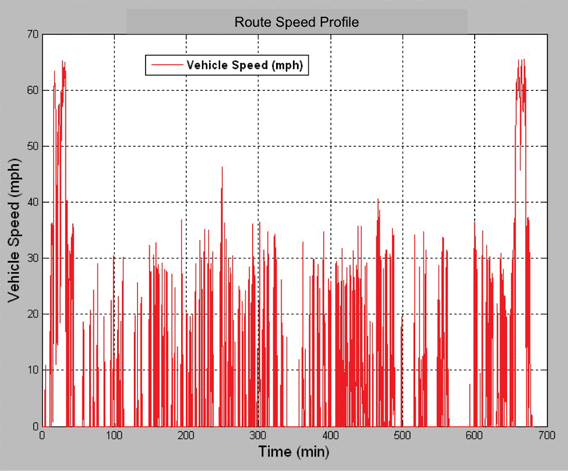
Fig. 2 — Potential savings from regenerative braking are proportional to the number of stops and starts of a vehicle. This actual vehicle route shows average speeds under 30 mph, with dozens of brake/accelerate cycles during a 12-hr day.
Save 30% on energy?
Optimal use of fluid power could allow all sorts of vehicles and power machinery, from dentists’ drills to jaws-of-life to backhoes, to cut energy consumption between 10 and 30%. This according to Kim Stelson, a University of Minnesota mechanical engineering professor and director of the new Engineering Research Center for Compact and Efficient Fluid Power.
“Back in the 1950s and 1960s, the United States led the world in fluid-power research, but now Europe and Asia have passed us by,” said Stelson. “We hope that this new center will get us back on track in this growing field.” Researchers at the center will study ways to use fluid power to improve efficiency in equipment for agriculture, mining, and construction, as well as equipment for manufacturing, such as injection-molding machines.
Fluid-powered hybrid vehicles are now in development by Eaton Corp., one of the center’s industry partners. The first applications of the technology will be in garbage trucks, other heavy trucks, and buses, all of which make frequent stops and starts and are big enough to hold a fluid-powered apparatus. The system uses regenerative braking to capture the kinetic energy of the vehicle as it slows down. If conventional friction brakes were used, that energy would be lost as heat.
“In a fluid-powered system, when you brake, a pump pumps fluid from a low-pressure reservoir to a high-pressure reservoir,” says Stelson. “This requires energy, which is stored in the high-pressure reservoir. When you release the brake, fluid flows out of the reservoir and drives the pump backward, turning it into a hydraulic motor to help power the vehicle.”
A trial of fluid-powered regenerative braking will soon get under way in the Chinese cities of Beijing and Shanghai. In preliminary tests, Eaton, which is conducting the trials, has shown that 80% of the braking energy is recovered and reused, resulting in a 30% fuel saving. Different savings will be realized in different types of machinery, but Stelson estimates at least $100 million of energy savings in each application. For example, backhoes equipped with fluid-powered technology could improve efficiency by 30%, and in passenger cars, perhaps 10%, saving $10 billion of the $100 billion now spent on fuel.
Regenerative braking stops, saves
Closer to home, Parker Hannifin is partnering with the US Environmental Protection Agency to develop hydraulic hybrid drives for heavy-duty stop-and-go trucks. Again, this focus is not on highway freight haulers, which are very efficient in their own way. But the emphasis is on trucks that have frequent stop and start cycles, like delivery trucks and refuse (garbage) trucks, Fig 2.
According to models developed by the EPA, such a hydraulic hybrid truck would deliver these benefits, Fig. 3.
1. Fuel mileage improvement ranging from 30% to 70%.
2. Reduced maintenance, especially of conventional friction brakes and starter motors.
3. Reduced emissions that comply with 2010 regulations.
4. Because the stored hydraulic power allows operation with engine off, the vehicle is safe for indoor operation and helps meet anti-idling laws.
In operation, this type of hydraulic hybrid operates with no mechanical connection between the engine and the driving wheels. Instead of a mechanical link, the engine output is directed to a hydraulic pump. Fluid from the pump goes to drive a hydraulic motor, which delivers its power into the vehicle transmission. A high-pressure accumulator and low-pressure reservoir ride on-line, Fig 4.
When vehicle brakes are applied, hydraulic fluid is directed into the high-pressure accumulator. Resistance to that flow creates a braking effect. And fluid stored in this high-pressure accumulator can be drawn upon to power the vehicle and move it forward after braking.
Parker is pleased with the strong technical partnership of the EPA, and plans to have a prototype ready for testing within one year. Their goal is to have a “fleet on the street’ by 2010.
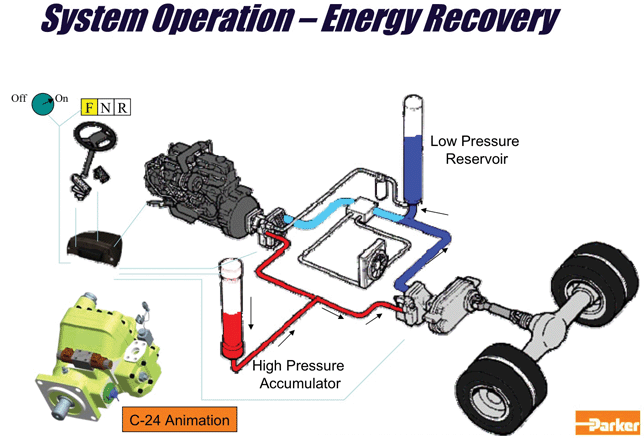
Fig. 3 — Hybrid drive uses a decoupled transmission, in which the engine drives a hydraulic pump, and the pumped fluid actuates a hydraulic motor that drives the vehicle. When brakes are applied, fluid is forced into the high-pressure accumulator, storing energy that can be used for the next acceleration.
Hydraulic Hybrids at SwRI
A Similar Effort is underway at Southwest Research Institute (SwRI), where engineers have been working with the EPA to develop hybrid technology for larger vehicles. Hybrid technology generally affords improved vehicle technology and reduced emissions through two processes. The first, as mentioned earlier, comes through recovering the energy that is typically lost through the brakes during stopping. The second is associated with operating the engine at conditions of inherently high efficiency most of the time.
The powertrain of a hybrid hydraulic vehicle consists of an engine, a hydraulic transmission, and a set of hydraulic accumulators. The accumulators store hydraulic energy just like batteries store electrical energy. During braking, the hydraulic transmission pumps hydraulic fluid from the low-pressure accumulator to the high-pressure accumulator, where it is stored in anticipation of the next vehicle acceleration. Accumulators allow the high power levels associated with braking to be absorbed efficiently for later reuse.
Development efforts during the past decade have been focused on component development and systems integration, with emphasis on storing hydraulic energy in accumulators. These devices are simple in concept, but are highly engineered components. Inside the accumulators, nitrogen gas is used to pressurize the hydraulic oil as it flows in from the hydraulic transmission during braking. The oil and gas must be kept separate in the accumulator to ensure that the oil does not carry gas through the hydraulic system. The loss of gas, particularly in the high-pressure accumulator, will diminish the ability of the system to store energy effectively.
While hydraulic components have been used in off-highway vehicles for decades, their on-highway use thus far has been somewhat limited because of a number of factors. For example, major development activities are being directed toward reducing the noise associated with hydraulic systems to improve their acceptance by the general public.
In addition to the efficiency gains realized by the recovery and reuse of brake energy, hydraulic systems are also being developed to drive engine accessories on these hybrid hydraulic vehicles. A single engine-driven, variable-displacement pump can power several hydraulic motors of different displacements to drive the fan, alternator, air conditioning compressor, water pump, engine oil pump and power steering system. This arrangement can improve the efficiency of the vehicle by matching the power demanded by each component to the power supplied by the engine.
For example, radiator fan speed can be decoupled from the engine speed using this system so that the fan can operate at whatever speed is needed to provide optimal air flow across the radiator to adequately cool the engine. At the same time, the engine water pump can be run at its optimal speed to provide the required flow of coolant through the engine. Thus, if the engine is operating at partial power or if the outside air temperature is low, the power directed to these and other engine accessories can be optimized and thus energy, and fuel, can be saved. (For more information on decoupled hydraulic fans, see “Off-Road Hydraulics,” in the May, 2007 issue of Design World.)
Hydraulic systems used in construction equipment likewise are receiving additional consideration pertaining to operational efficiency. The hydraulics industry has migrated from open-center, fixed-displacement pumps to pressure and pressure/flow-compensated pumps in an attempt to improve efficiency of the hydraulic system by providing the flow needed for the maximum pressure required by the hydraulic system. The problem with this current best-practices approach is that the hydraulic system requirements typically vary from component to component.
The SwRI team has recommended that the off-highway equipment industry instead consider using multiple hydraulic pumps to satisfy the needs of the various circuits used in equipment such as excavators. One simulation study, involving a hydraulic excavator undergoing a truck loading cycle, showed a 46% reduction in fuel consumption using this regenerative hydraulic circuit.
Because they allow engine speed to be decoupled from vehicle speed, hybrid hydraulic powertrains allow the engine to operate at maximum efficiency as the hydraulic components provide the required variability of operation. All engines have an optimum efficiency point for each combination of power and speed; hybrid hydraulic vehicles can keep the engine operating along this optimum efficiency curve over many different operating conditions.
The EPA, supported by SwRI, has placed into service a hybrid hydraulic commercial delivery vehicle to verify the fuel efficiency gains that have been predicted through modeling and simulation and obtained in laboratory tests. EPA anticipates that the cost/benefit ratio of this hybrid powertrain will be better than that of an equivalent-size hybrid electric powertrain because of the proven performance, reliability and relatively low cost of hydraulic components.
Parker Hannifin Corp.
www.parker.com
Eaton Corp.
www.eaton.com
Filed Under: Hydraulic equipment + components, Pneumatic equipment + components, Automotive, FLUID POWER

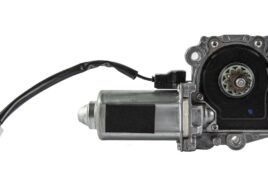
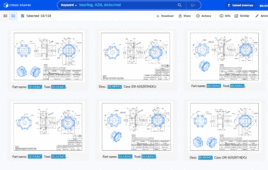

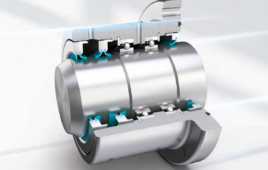
As an inventor of the New Modular Hydraulic Powertrain (MHP) (See Google: Grigoriy Epshteyn Patents) I would like to introduce my stunning innovation for partnering in realization.
The patented in U.S., Japan and China MHP includes Any Power Single Cylinder Omnivorous Diesel engine with coaxially build-in supercharger and pump fastened by valve plate to standard hydrostatic motor driving car without hoses and pipes. Engine piston fastened to pump’s plunger. Swash plate synchronizing mechanism provides fully balanced opposite motion of engine and supercharger pistons, continuously variable displacement (CVD) and continuously variable compression ratio (CVCR) with about three time greater fuel economy.
Such impressive number confirms the University of Michigan Automotive Research Center
(see http://me.engin.umich.edu/autolab/Publications/P2009_10.htm).
This research got a result of 77.68 mpg on the highway and 46.50 mpg in city fuel consumption for a mid-size passenger car due to the CVD gasoline engine with the following conclusion: “The advanced powertrain configuration investigated in this work is a high performance option for the mid-size passenger vehicle. Therefore, while predict fuel economy improvements are impressive, they do not represent the ultimate potential.” and the conclusion continues: “…and possible benefits of using a variable compression ratio is apparent”.
The MHP diesel has additional benefits and, for example, the existent mid-size car like Ford “Taurus” with 90 mpg is possible by retrofitting only engine and automatic transmission!
E-mail: [email protected]